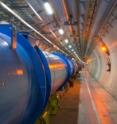CU-Boulder team aids in record-breaking subatomic particle collisions
A group of University of Colorado at Boulder faculty and students involved in the international Large Hadron Collider project in Europe are celebrating the most powerful smashing of subatomic particles into each other today in a quest to discover the physical conditions immediately following the Big Bang. In the experiments conducted March 30 at a 17-mile underground loop facility below the Swiss-French border in Geneva, scientists crashed proton beams together at three and one-half times the highest energy levels ever recorded, said CU-Boulder Professor William Ford, one of 17 CU-Boulder physics department faculty, postdoctoral researchers, graduate students and technicians involved in the project. The combined energy level of the two-beam collisions was 7 trillion electron volts, said Ford.
"Today was a very significant milestone, and we could not be more excited about the results," said Ford. "This project and the measurements we have begun making have huge implications for our graduate students. These students will be getting real data they can work with to make new discoveries."
Nine members of the CU-Boulder team have been flying back and forth to work shifts at the European Organization for Nuclear Research Facility known as CERN, which operates the LHC, during the past two weeks. CU-Boulder researchers have been involved in the LHC project for the past five years, said Ford.
Recreating conditions following the Big Bang using the LHC is expected to provide new information about mysterious dark matter, dark energy, gravity and the fundamental laws of physics. The experiments may even shed light on the possibility that other dimensions exist, according to physicists.
The CU-Boulder research team has been working on the Compact Muon Solenoid, or CMS, one of four massive particle detectors in the collider and which weighs more than 12,500 tons. The team is primarily involved with the CMS forward pixel detectors -- the "eyes" of the device -- that help researchers measure the direction and momentum of subatomic particles following collisions as they penetrate 25 million different silicon elements and provide clues to their origin and structure, said physics Professor John Cumalat, another member of CU-Boulder's LHC team.
One target of the LHC effort is to find evidence of the elusive Higgs boson, a theoretical elementary particle that has been predicted by physicists and is believed to hold clues to the mass of matter. "This is a very exciting project because we are on the frontier of energy," said Cumalat. "This project undoubtedly holds some very big surprises for us over the coming months and years."
In addition to Ford and Cumalat, other CU-Boulder physics professors involved in the LHC project include Uriel Nauenberg, Jim Smith, Kevin Stenson and Steve Wagner. The effort also involves CU-Boulder postdoctoral researchers Mauro Dinardo, Ale Gaz, Eduardo Luiggi, Keith Ulmer and Shilei Zang, as well as graduate students Chris Edelmaier, Brian Drell, Bernadette Heyburn and Alyssa Proulx as well as technical staff members Eric Erdos and Doug Johnson.
"Our involvement in this project is potentially a huge recruiting tool that will help us to continue to bring the most talented graduate students to CU-Boulder," said Cumalat.
Sixteen years in the making, the $3.8 billion LHC project involves an estimated 10,000 people and staff from 60 countries, including more than 1,700 scientists, engineers, students and technicians from 94 American universities and laboratories supported by the U.S. Department of Energy's Office of Science and the National Science Foundation. The United States is providing about $530 million, primarily for the LHC detectors.
The amount of steel used in the magnetic yoke of the LHC's CMS is equivalent to the amount of steel used to build the Eiffel Tower.
Source: University of Colorado at Boulder
Other sources
- CU-Boulder team aids in record-breaking subatomic particle collisionsfrom Science BlogWed, 31 Mar 2010, 16:14:30 UTC
- McGill Students Brace for Subatomic Collisionsfrom Newswise - ScinewsTue, 30 Mar 2010, 15:21:29 UTC
